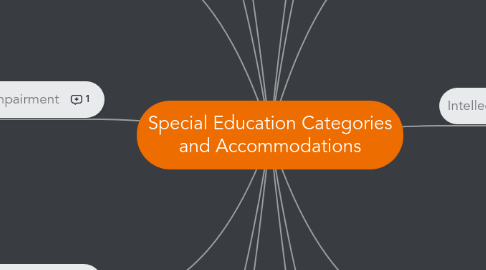
1. Autism
1.1. Intervention
1.1.1. Minimized visual distractions, reduction of visual clutter, and natural lighting (Stokes)
1.2. Modification
1.2.1. Use Task Analysis –very specific, tasks in sequential order (Hensley)
1.3. Assistive Technology
1.3.1. "Picture This" This program allows for the presentation of real photos, without risking ambiguous background clutter (Stokes)
2. Deaf-Blindness
2.1. Intervention
2.1.1. Small group and individual Instruction (tsbvi.com)
2.2. Modification
2.2.1. A personalized curriculum with self pace (projectsalute)
2.3. Assistive Technology
2.3.1. Deaf-Blind Communicator (DBC) (Bhattacharyya)
3. Emotional Disturbance
3.1. Intervention
3.1.1. Engage student in role-play opportunities to practice appropriate responses (do2learn)
3.2. Assistive Technology
3.2.1. Visual/Auditory Prompts - Devices that provide speech, visual and/or auditory prompts regarding student behavior or steps to be completed in an academic task, rules, and other important sequences (Parette, Crowley, Wojcik)
3.3. Modification
3.3.1. Break assignments into “chunks” to avoid overwhelming the student (do2learn)
4. Other Health Impairment
4.1. Intervention
4.1.1. Teach critical instruction in the mornings (Brock)
4.2. Modification
4.2.1. Keep assignments brief with immediate feedback (Brock)
4.3. Assistive Technology
4.3.1. Talking calculators
5. Speech or Language Impairment
5.1. Intervention
5.1.1. work on the early developing sounds “k, g, f.” With a visual models and cues
5.2. Modification
5.2.1. Allow students to substitute oral assignments with written ones (fentress)
5.3. Assistive Technology
5.3.1. First Words, a language program that has a number of applications for teaching those who are developing or reacquiring language functions
5.4. Case Study
5.4.1. http://glennweybright.com/case-studies/little-girl-with-an-articulation-disorder/
6. Visual Impairment, Including Blindness
6.1. Intervention
6.1.1. The teacher needs to explain everything she is doing, clearly and concisely
6.2. Modification
6.2.1. Extra time on assignments, especially when first learning
6.3. Assistive technology
6.3.1. Keyboard shortcuts for using computers
6.4. Case Study
6.4.1. http://www.washington.edu/doit/robbie-and-computer-course-case-study-computing-access-students-who-are-blind
7. Traumatic Brain Injury
7.1. Intervention
7.1.1. Have consistent routines. This helps the student know what to expect. If the routine is going to change, let the student know ahead of time (projectidealonline)
7.2. Modification
7.2.1. Show the student how to perform new tasks. Give examples to go with new ideas and concepts
7.3. Assistive Technology
7.3.1. Tinted overlays for reading (this may help with visual processing)
8. Deafness
8.1. Intervention
8.1.1. Instruction in a large group (tsbvi.com)
8.2. Modification
8.2.1. Use of an Interpreter (online.sju)
8.3. Assistive Technology
8.3.1. C-Print which is a speech-to-text computer system (online.sju)
9. Developmental Delay
9.1. Intervention
9.1.1. Early interventions - Early intervention specialists talk to the family about activities, games, and exercises they can do to assist their child and discuss the family's needs
9.2. Modification
9.2.1. Break down tasks into smaller steps (do2learn)
9.3. Assistive Technology
9.3.1. Ginger Software - Communicate quickly and accurately with Ginger’s intuitive, writing experience and with writing tools that help you express yourself.
10. Hearing Impairment
10.1. Intervention
10.1.1. Seat the student in the second row and a little off to one side of the classroom. If he or she has a better hearing ear, that ear should be facing the teacher (Anderson)
10.2. Modification
10.2.1. Student notetakers can be used so that the student with hearing loss can focus on the instruction (Anderson)
10.3. Assistive Technology
10.3.1. The teacher wears a microphone transmitter and the child is able to hear the teacher’s voice through the FM device (Anderson)
11. Intellectual Disability
11.1. Intervention
11.1.1. Ask student for input about how they learn best, and help them to be in control of their learning (do2learn)
11.2. Modification
11.2.1. Proceed in small ordered steps and review each frequently (do2learn)
11.3. Assistive Technology
11.3.1. Communicators are computers that allow a person to communicate audibly by pointing to particular images, or typing in a message (vtnetwork)
12. Multiple Disabilities
12.1. Intervention
12.1.1. Peer tutoring has been proven to have positive results for students with multiple disabilities (projectidealonline)
12.2. Modification
12.2.1. Individualized curriculum and pacing to help with each disability
12.3. Assistive Technology
12.3.1. Interactive white board that are connected with computers (SmartBoards)
13. Orthopedic Impairment
13.1. Intervention
13.1.1. Instruction focused on development of gross and fine motor skills (projectidealonline)
13.2. Modification
13.2.1. Adapted Physical Education Teachers, who are specially trained PE teachers who work along with the OT and PT to develop an exercise program to help students with disabilities
13.3. Assistive Technology
13.3.1. Specialized chairs, desks, and tables for proper posture development
14. Specific Learning Disability
14.1. Intervention
14.1.1. Specialized tutoring to help with specific disabilty
14.2. Modification
14.2.1. Let students participate in hands on intensive learning
14.3. Assistive Technology
14.3.1. a Text to Speech software with natural sounding voices
14.4. Case Study
14.4.1. https://www.dynaread.com/case-study-age-ten

